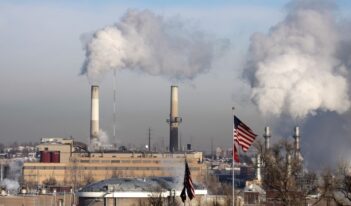
Integrating employment effects into regulatory impact analysis could improve the public debate on regulation.
When the Environmental Protection Agency (EPA) finalized its Mercury and Air Toxics Standards (MATS) and Cross-State Air Pollution Rule (CSAPR) in 2011, the American Coalition for Clean Coal Electricity (ACCCE) forecasted a 1.4 million job-year loss due to the costs the rules were expected to impose. By contrast, the Political Economy Research Institute (PERI) predicted a 1.4 million job-year gain as a result of these same regulations. Utility lobbyists and environmental groups pitted the two advocacy analyses against each other during congressional hearings, igniting a heated policy debate. Absent from that debate, though, was any rigorous, balanced, and transparent analysis, say legal experts Michael Livermore and Jason Schwartz in a chapter appearing in a new book produced by the Penn Program on Regulation.
 Livermore and Schwartz argue that regulatory analyses incorporating employment effects hold value beyond their use in calculating the benefits and costs of new regulations. They believe that the value of job impact analysis lies in its potential to serve as a deliberative tool that would inject reason into the jobs and regulation debate—a debate that has grown clouded with muddled political rhetoric. While including job effects would add a layer of complexity to cost-benefit analysis and come at an opportunity cost, such analysis would enlighten the political discourse and inform the public, say Livermore and Schwartz. By enabling citizens to assess regulations in light of job effects, federal agencies would be better able to justify regulatory choices to the public—an activity fundamental to a democracy.
Livermore and Schwartz argue that regulatory analyses incorporating employment effects hold value beyond their use in calculating the benefits and costs of new regulations. They believe that the value of job impact analysis lies in its potential to serve as a deliberative tool that would inject reason into the jobs and regulation debate—a debate that has grown clouded with muddled political rhetoric. While including job effects would add a layer of complexity to cost-benefit analysis and come at an opportunity cost, such analysis would enlighten the political discourse and inform the public, say Livermore and Schwartz. By enabling citizens to assess regulations in light of job effects, federal agencies would be better able to justify regulatory choices to the public—an activity fundamental to a democracy.
Livermore and Schwartz argue that efficiency grounds alone do not warrant resource-intensive job impact analysis in most cases. For example, they point to the EPA’s cost-benefit analysis of the Cross-State Air Pollution Rule, in which the agency estimated that the rule would generate $280 billion in annual net benefits, avoiding up to 34,000 premature deaths per year. Estimated employment effects were much more modest by comparison. The agency projected that new regulatory compliance programs would create a positive 2,230 job years and estimated that the annual net effect on regulated industries would range from -1,000 to +3,000 job years. Similarly, for its Boiler MACT Rule, which instituted emission limits on hazardous air pollutants from industrial boilers, EPA put estimated annual net benefits between $25.2 and $65.5 billion and premature deaths avoided at 8,000. However, net employment effects fell between -4,000 and +8,300 jobs. As the academic literature notes, and Livermore and Schwartz confirm, save for rare cases, employment effects are unlikely to shift a rule’s cost-benefit calculus.
Nonetheless, Livermore and Schwartz argue, opponents and proponents of regulation have in recent years deployed exaggerated and unsubstantiated claims about employment impacts, particularly in the arena of environmental regulation. Advocacy groups’ economic reports have proliferated in public discourse, fueling an overheated, politicized debate on jobs and regulation. Yet, while these advocacy reports have been quick to provide seemingly definitive numbers to bolster competing claims, a discussion of the studies’ assumptions, uncertainties, and limitations has been absent from the political debate.
Livermore and Schwartz examine two industry reports released in August 2010 predicting that the Boiler MACT Rule would result in hundreds of thousands of jobs lost. The first, produced by the Council of Industrial Boiler Owners (CIBO), estimated that the rule would put 800,000 jobs “at risk,” while the second, by the American Forest and Paper Association (AFPA), claimed that 90,000 jobs were “at risk.” Despite these assertions, both were riddled with shortcomings, Livermore and Schwartz say. For example, in addition to never defining what “at risk” meant, the CIBO report apparently chose an improper econometric model for the analysis, failing to take long-term, structural changes into account. According to Livermore and Schwartz, the AFPA’s number was a guess, at best: the study assumed that an increase of 12.5 percent or more to a mill’s production costs would put all of that mill’s workers “at risk.” Both studies were repeatedly cited in congressional hearings and press releases, say the authors, with the AFPA study becoming the basis of a bill to delay the rule.
Livermore and Schwartz argue that job impact analysis would enable administrative agencies to restore reason, clarity, and transparency to the public debate on regulation. According to the authors, an agency’s analysis could function as a check on the more extreme claims made by interest groups and help those without a technical background make a balanced, informed assessment of a rule’s impacts. Moreover, although employment effects may not change a given rule’s efficiency calculus, their incorporation could highlight salient distributional effects that cannot be seen in an aggregate analysis. Finally, while individual regulatory policies may not significantly shift labor demand or supply, some have argued that collectively, they may affect employment. Examining cumulative employment effects, Livermore and Schwartz say, would allow agencies to test these claims. Overall, job impact analysis can not only ensure more targeted, appropriate policy responses from the government but also provide the public with a broader, more balanced perspective on regulatory policies.
Integrating employment effects into regulatory impact analysis is a complex, challenging endeavor, acknowledge Livermore and Schwartz. However, they argue that it is a worthwhile one, helping to restore reason to the jobs and regulation debate.
Livermore and Schwartz’s work appears as a chapter in the recently published book, Does Regulation Kill Jobs?, edited by Cary Coglianese, Adam Finkel and Christopher Carrigan.
This essay is part of The Regulatory Review’s six-part series, Does Regulation Kill Jobs?



